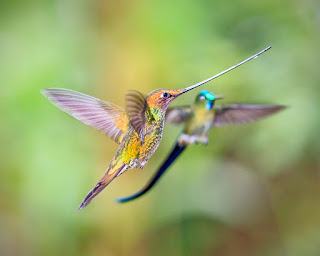I had not been back in
Ecuador for about twenty years. Quito
has a brand new airport that eliminated the anxieties of landing in the old
one, where the landing approach was between the mountains, so close that it
appeared that at anytime the tips of the wings were going to be torn
away. The drive along the mountain roads
was then dangerous; expecting that at
the next curve there would be no road. The
highways now are now first class (at
least the ones I traveled on). Overall I observed great improvement. And the
currency is the “mighty dollar”; no fuss with money exchanges.
Photographing hummingbirds is easy; you visit
various lodges in the mountain that specialize in this endeavor. One select lodging is at different altitudes,
since the vertical differences give one the opportunity of photographing
different species. Below is an Andean Emerald followed by a Sparkling Violetear.


Hummingbird photography has
become very sophisticated but I only used one flash and sat near the feeders
waiting for the flying jewels to fly by… easy to capture them since they are so
fast. Others use multiple flashes and
enclosures to control the backgrounds.
And most likely when you see a hummingbird libating from a flower, it
was a set-up where sugar water is added to attract them. Yes, some of my images were done that way but
when birds are flying it is a different story; these are mostly pure luck to
capture since they are so fast. The two
images below have a great flaw that most observers will not notice. First, a banana flower and when hanging from the
plant, it points down; here it is pointing up and was filled with sugar water. In the third image below, the flower was cut
from the plant and held on a pedestal - also baited with sugar water. Giving away secrets of the trade. Below is a Fawn-breasted Brilliant followed by a Booted Racket-Tail with a wasp (the
hummers stay away from flowers with wasps).
Then the later image is again with a Purple-bibbed Whitetip and a Booted
Racked Tail visiting a flower.



The next images were not
set-up; they were captured in a normal environment but no doubt were attracted
to the area by the activities of the other hummingbirds. These are not concerned with the presence of
people and would at times land on your camera gear; I have red strap camera
connectors and they will come and sit on them; these birds are definitely
attracted to bright red and yellow flowers.
This way the plants ensure that
their flowers will be pollinated. Hummers
do not only feed on honey but on small flying insects and maneuvering while
chasing them, perform aerobatics that would make the Blue Angels jealous.
Below we have a lazy one, a Purple-bibbed Whitetip does not want to fly to get
his sweets followed by the Violet-tailed Sylph, probably the nicest looking one
I saw.


Hummingbirds are very territorial and will claim ownership
of a feeder and guard it by chasing the others away when they attempt to
feed. This results in lengthy battles
and I witnessed at times them using their bills like thrusting swords to the
body and at times locking bills. But in
the end, one is chased away. Those fighting are Booted Racket-Tails followed by
the image of a Buff-tailed Coronet.
Below are the Sword-billed hummingbird and the Long-tailed
Sylph (in the background out of focus) who were visiting the same feeder. The
Sword-billed did not stick the bill in the feeder but used the tongue to lap
the liquid as a dog would drink.
There are other birds that will fly by such as the Toucan
Barbet that has caught a moth. They
don’t eat the wings so they beat the insect against a branch until the wings
are dislodged. In one of the lodges they
had a feeder with fruits that attracted red squirrels closely observed by
Crimson-rumped Toucanet; they seem not to mind each other. And to complete this blog - a gorgeous bird,
the Rufous Motmot.


















2 comments:
Stunning birds and photographs Jose. Yes, there are always secrets to getting good photographs of things and I too like to sharing any information I have with people.
We do not have hummingbirds here. Instead, we have sunbirds ..... nearly the same with bright colours but their beaks are curved.
Thanks for a great post.
Wonderful job. Images turned out great. Nice diversity and quality. Blue Skies.
Post a Comment